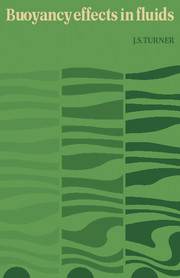Book contents
- Frontmatter
- Contents
- Preface
- 1 INTRODUCTION AND PRELIMINARIES
- 2 LINEAR INTERNAL WAVES
- 3 FINITE AMPLITUDE MOTIONS IN STABLY STRATIFIED FLUIDS
- 4 INSTABILITY AND THE PRODUCTION OF TURBULENCE
- 5 TURBULENT SHEAR FLOWS IN A STRATIFIED FLUID
- 6 BUOYANT CONVECTION FROM ISOLATED SOURCES
- 7 CONVECTION FROM HEATED SURFACES
- 8 DOUBLE-DIFFUSIVE CONVECTION
- 9 MIXING ACROSS DENSITY INTERFACES
- 10 INTERNAL MIXING PROCESSES
- Bibliography and Author Index
- Recent Publications
- Subject Index
- Plate section
6 - BUOYANT CONVECTION FROM ISOLATED SOURCES
Published online by Cambridge University Press: 05 August 2012
- Frontmatter
- Contents
- Preface
- 1 INTRODUCTION AND PRELIMINARIES
- 2 LINEAR INTERNAL WAVES
- 3 FINITE AMPLITUDE MOTIONS IN STABLY STRATIFIED FLUIDS
- 4 INSTABILITY AND THE PRODUCTION OF TURBULENCE
- 5 TURBULENT SHEAR FLOWS IN A STRATIFIED FLUID
- 6 BUOYANT CONVECTION FROM ISOLATED SOURCES
- 7 CONVECTION FROM HEATED SURFACES
- 8 DOUBLE-DIFFUSIVE CONVECTION
- 9 MIXING ACROSS DENSITY INTERFACES
- 10 INTERNAL MIXING PROCESSES
- Bibliography and Author Index
- Recent Publications
- Subject Index
- Plate section
Summary
The buoyancy effects discussed so far have for the most part been stabilizing, or have been assumed to produce a small modification of an existing turbulent flow. Now we turn to convective flows, in which buoyancy forces play the major role because they are the source of energy for the mean motion itself. The usual order of presentation will be reversed: it is convenient to set aside for the present the discussion of the mean properties of a convecting region of large horizontal extent, and flows near solid bodies, and in this chapter to treat various models of the individual convective elements which carry the buoyancy flux. (See Turner (1969a) for a review of this work and a more extensive bibliography.)
Such models can be broadly divided into two groups, those which assume the motion to be in the form of ‘plumes’ or of ‘thermals’. (See fig. 6.1.) In both of them motions are produced under gravity by a density contrast between the source fluid and its environment; the velocity and density variations are interdependent, and occupy a limited region above or below the source. Plumes, sometimes called buoyant jets, arise when buoyancy is supplied steadily and the buoyant region is continuous between the source and the level of interest. The term thermal is used in the sense which has become common in the meteorological literature to denote suddenly released buoyant elements.
- Type
- Chapter
- Information
- Buoyancy Effects in Fluids , pp. 165 - 206Publisher: Cambridge University PressPrint publication year: 1973
- 9
- Cited by

